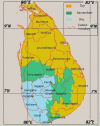On the road to eliminate malaria in Sri Lanka: lessons from history, challenges, gaps in knowledge and research needs
- PMID: 24548783
- PMCID: PMC3943480
- DOI: 10.1186/1475-2875-13-59
On the road to eliminate malaria in Sri Lanka: lessons from history, challenges, gaps in knowledge and research needs
Abstract
Malaria is one of the most important tropical diseases that has caused devastation throughout the history of mankind. Malaria eradication programmes in the past have had many positive effects but failed to wipe out malaria from most tropical countries, including Sri Lanka. Encouraged by the impressive levels of reduction in malaria case numbers during the past decade, Sri Lanka has launched a programme to eliminate malaria by year 2014. This article reviews the historical milestones associated with the malaria eradication programme that failed subsequently and the events that led to the launch of the ongoing malaria elimination plans at national-level and its strategies that are operational across the entire country. The existing gaps in knowledge are also discussed together with the priority areas for research to fill in these gaps that are posing as challenges to the envisaged goal of wiping out malaria from this island nation.
Figures




References
-
- WHO. World Malaria Report 2013. Geneva: World Health Organization; 2013.
-
- WHO. Malaria. Handbook of resolutions and decisions of the World Health Assembly and the Executive Board. Geneva: World Health Organization; 1973.
-
- Macdonald G. The epidemiology and control of malaria. London: Oxford University Press; 1957.
Publication types
MeSH terms
LinkOut - more resources
Full Text Sources
Other Literature Sources
Medical
Miscellaneous

